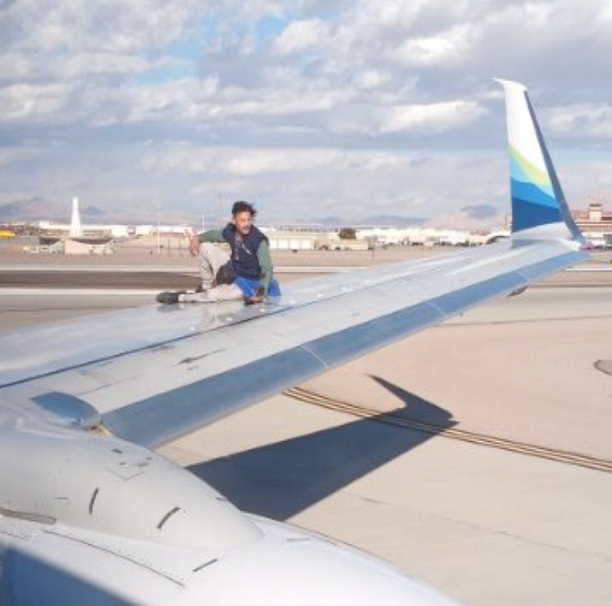Il thread leggero
- Autore Discussione Dancrane
- Data d'inizio
TW 843
Senior Member
Prego?Ho l'impressione che TW843 si sia sentito punto sul vivo agli epiteti "stronzo" e "negazionista"
EI-MAW
Utente Registrato
- 25 Dicembre 2007
- 7,135
- 1,380
Abbi pazienza, ma c’è ben poco da intendere. L’annuncio dice “vi preghiamo si spegnere completamente...”, non “vi preghiamo di selezionare la modalità d’uso aereo”. Sono due cose diverse e davvero molto semplici, ma mi rendo conto che gli annunci a bordo sono solo un fastidioso rumore di sottofondo, nessuno ascolta niente, da questo a anche semplicemente dove sistemare un bagaglio o quando allacciare le cinture. Zero totale. Aggiungiamoci poi che ora più della metà si isola in auricolari e cuffione, alè!Io non avevo mai inteso quell'annuncio fosse proprio "spegnete i telefoni", quanto piuttosto: "assicuratevi che siano davvero in modalità aereo".
Un telefono in modalità aereo in borsa che tipo di segnale disturbante può emettere?
TW 843
Senior Member
Non ero io, ahimè, visto che io volo su voli az covid-free stravuoti as you know.mi spieghi la "polveriera di cazzate e l'ignoranza" che questo racconto contiene, te ne sarei grato. Se le regole sono quelle che vengono chiaramente annunciate a bordo, la Lucarelli ha ragione. A meno che quell'"imbruttito" eri tu
L’annuncio di Spegnere il cellulare durante l’autoland l’ho sentito in decine e decine di voli. E mi non sono mai dovuto adeguare visto che io il cellulare lo spengo di default, sempre, su ogni volo. Quindi evita, grazie.
Detto questo tornando sul peana selvaggino, il concetto intollerabile è quello di ergersi a depositaria della verità. Il vicino non ha spento il cellulare all’annuncio? (E ha fatto male imho). Allora secondo lei diventa subito un negazionista un no-vax un coglione uno da sterminare, il nemico pubblico N1. Ma dove? Chi le ha detto che questo sia uno che non crede al covid di default? Come si permette di sentenziare? colpevole a prescindere.
Poi parte il delirio da TSO sulla morte augurata e auspicata a tutti. Ci fa sapere che Persino madama è disposta a lasciarci le penne da martire pur di salvare il mondo da chi lascia il cellulare in modalità aereo.
Fate voi.
Appunto come dici tu, siccome alla gente se si chiede di fare una cosa non si ha la certezza che la facciano, pensavo si rincarasse la dose dicendo "spegnere i cellulari" per essere poi sicuri al 100% che fossero almeno in modalità aereo.Abbi pazienza, ma c’è ben poco da intendere. L’annuncio dice “vi preghiamo si spegnere completamente...”, non “vi preghiamo di selezionare la modalità d’uso aereo”. Sono due cose diverse e davvero molto semplici, ma mi rendo conto che gli annunci a bordo sono solo un fastidioso rumore di sottofondo, nessuno ascolta niente, da questo a anche semplicemente dove sistemare un bagaglio o quando allacciare le cinture. Zero totale. Aggiungiamoci poi che ora più della metà si isola in auricolari e cuffione, alè!
Per dire: se vuoi "10" devi chiedere almeno "20" per essere certo del risultato.
Questo perché, nella mia ignoranza (e ho appunto chiesto nel post precedente, in attesa di una risposta), ho sempre pensato che un cellulare in modalità aereo riposto nella borsa (quindi non in uso) non emetta alcun segnale/impulso/frequenza/onda elettromagnetica. È così o no?
13900
Utente Registrato
- 26 Aprile 2012
- 10,294
- 8,137
Qui una buona risposta su Stackexchange che ricopio di sotto:È così o no?
Short answer: ILS is rather sensitive to interference and not all electronic devices take much precaution in avoiding the generation of interference. The pilot wants to be sure that the readings he's getting on the localizer and glideslope are accurate, since he can't actually see the runway to verify the final approach path visually.
Longer answer: ILS is actually relatively simplistic as RF signals go. Both the localizer and the glideslope just consist of a pair of AM signals that are broadcast directionally. For both systems, the modulated frequencies are 90 Hz and 150 Hz. For the localizer, 90 Hz is broadcast to the left of the runway centerline and 150 Hz is broadcast to the right of the centerline. When the aircraft is aligned with the runway, it will receive equal strength signals of both frequencies. When it's to the right, it will receive more power from the 150 Hz signal and when it's to the left, it will receive more power from the 90 Hz signal. The glideslope works pretty much the same way, just with the 150 Hz signal transmitted below the glide path and the 90 Hz signal transmitted above it. [1] [2]
Now, suppose some passenger's electronic device is emitting a frequency that it shouldn't be. This is not exactly unheard of among consumer electronic devices. This is more common among devices manufactured in countries with less-strict emissions testing requirements/enforcement, but it's possible due to slight defects in almost any device. [Source: I design RF receivers for a living.] Now suppose that this noise happens to be on the localizer or glideslope frequency for the runway to which the aircraft is flying an approach. Hopefully you're starting to see a problem here... Whatever amplitude changes are happening on this unintended emission are now being received by the AM demodulator of the localizer or glideslope, potentially confusing it and, in low visibility conditions, causing the aircraft to be directed somewhere other than the runway threshold. Needless to say, that's bad.
Boeing recommends the following actions for flight crews flying ILS approaches in order to detect erroneous ILS readings:
However, even when following those instructions, slightly erroneous ILS signals may be hard to detect until too late. If a DME is showing that you're half a mile off, you can probably notice that, but a couple hundred feet off might not be noticeable (but is still plenty to be a big problem.)
- Crosschecking altitude and DME distance periodically.
- Crosschecking altitude and flight management system (FMS) threshold distance.
- Crosschecking altitude and the crossing altitude of the outer marker (or locator, very-high-frequency omnirange [VOR] navigation equipment, or FMS).
- Crosschecking radio altitude and barometric altitude.
- Crosschecking ground speed and rate of descent.
- Questioning air traffic controllers when indications do not appear to be correct.
Lo facciamo anche noi irlandesi l'annuncio in CAT IIIVabbè è solo un attacco un po' romanzato alla maleducazione.
Ma davvero si fa quell'annuncio in caso di CATIII?
Grazie.Qui una buona risposta su Stackexchange che ricopio di sotto:
Ho trovato anche questo:
Quindi emissioni possibili di un cellulare in modalità aereo sono le ELF (Extremely Low Frequency, da 3 a 30 Hz) dei componenti elettrici, come per qualsiasi apparecchio in funzione.
Il problema sta nascendo ora col 5G, al quale vengono attribuiti problemi di disturbo ai segnali del Radio Altrimento. E questi potrebbero essere volatili per diabetici.
Giusto per farci un un'idea di cosa comporta una avaria al RadAlt:

 it.m.wikipedia.org
it.m.wikipedia.org
Giusto per farci un un'idea di cosa comporta una avaria al RadAlt:

Volo Turkish Airlines 1951 - Wikipedia
 it.m.wikipedia.org
it.m.wikipedia.org
crazyale
Utente Registrato
- 4 Settembre 2008
- 218
- 5
Hola, hola, hola, vo a passeggiare sulla piazzola!
Video dello squilibrato disponibili in rete

 viewfromthewing.com
viewfromthewing.com
Ha vanamente tentato la scalata alla winglet, senza successo, e alla fine è cascato dall’ala.

Man Crashes Truck Through A Fence, Scales A Plane Headed To Portland, Slips And Falls Off - View from the Wing
Alaska Airlines flight 1367 from Las Vegas to Portland departed over 4 hours late on Saturday after a a man drove a truck through the fence at Las Vegas McCarran International Airport and onto the tarmac - and proceeded to climb onto the wing of the Boeing 737-900. You can see that he doesn't...
Ha vanamente tentato la scalata alla winglet, senza successo, e alla fine è cascato dall’ala.
- 1 Febbraio 2012
- 12,499
- 2,633
Questa citazione non è per tutti!Hola, hola, hola, vo a passeggiare sulla piazzola!

Che botta, comunque!
Io direi che ha cercato di accoppiarsi con la wingletVideo dello squilibrato disponibili in rete

Man Crashes Truck Through A Fence, Scales A Plane Headed To Portland, Slips And Falls Off - View from the Wing
Alaska Airlines flight 1367 from Las Vegas to Portland departed over 4 hours late on Saturday after a a man drove a truck through the fence at Las Vegas McCarran International Airport and onto the tarmac - and proceeded to climb onto the wing of the Boeing 737-900. You can see that he doesn't...viewfromthewing.com
Ha vanamente tentato la scalata alla winglet, senza successo, e alla fine è cascato dall’ala.
